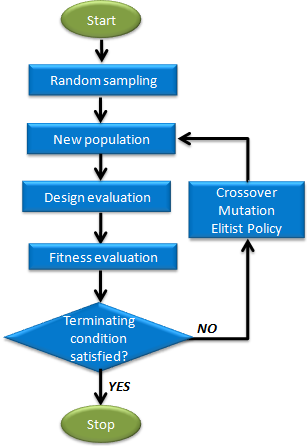Setting
|
Default
|
Range
|
Description
|
Discrete states
(GADISC)
|
1024
|
Integer > 1
|
Number of discrete values uniformly covering the range of continuous variables including upper and lower bound. Recommendation: select as a power of 2, e.g. 64 = 2^6, 1024 =2^10, etc.
Larger value allows higher solution precision, but more computational effort is needed to find the optima.
|
Mutation rate
(GAMUTR)
|
0.01
|
0.0 – 1.0
|
Mutation rate (probability)
Recommended range: 0.001 – 0.05
Larger values introduce a more random effect. As a result, GA can explore more globally but the convergence could be more slowly.
|
Elite population %
(GAELIT)
|
10
|
1.0 – 50.0
|
Percentage of population that belongs to elite.
The one with high fitness value is directly passed to the next generation. This is a very important strategy in GA to ensure the quality of solutions be non-decreasing. Larger value means that more individuals will be directly passed to the next generation. So new gene has less chance to be introduced. The convergence speed could be increased. The drawback is that too large value could cause premature convergence.
Recommended range: 1.0 – 20.0.
|
Random Seed
(GAREPT)
|
1
|
Integer
0 to 10000
|
Controlling repeatability of runs depending on the way the sequence of random numbers is generated.
|
0
|
Random (non-repeatable).
|
> 0
|
Triggers a new sequence of pseudo-random numbers, repeatable if the same number is specified.
|
Number of contenders
(GATOUR)
|
2
|
Integer
2 to 5
|
Number of contenders in a tournament selection.
For larger value, individuals with lower fitness value have less chance to be selected. Thus, the good individuals have more chance to produce offspring. The bad effect is that, diversity of the population is reduced. GA could converge prematurely.
|
Penalty multiplier
(GAPMUL)
|
2.0
|
> 0.0
|
Initial penalty multiplier in the formulation of the fitness function as exterior penalty function. Penalty multiplier will be increased gradually with iterating steps going on.
In general, larger value allows the solution to become feasible with less iteration steps; but too large value could result in a worse solution.
Recommended range: 1.0 – 5.0.
|
Penalty power
(GAPPOW)
|
1
|
> 0.0,
< 10.0
|
Penalty power in the formulation of the fitness function as exterior penalty function.
Recommended range: 1.0 – 2.0.
|
Distribution Index
(GAINDX)
|
5
|
Integer
1 to 100
|
Distribution index used by real coded GA.
This parameter is to control offspring individuals to be close to or far away from the parent individuals. Increasing the value will result in offspring individuals being closer to the parents.
Recommended range: 3 – 10.
|
Hybrid Algorithm
(GALOCAL)
|
0
|
0, 1 or 2
|
The hybrid algorithm used in GA.
0 hybrid1 (Hooke-Jeeves method)
1 hybrid2 (Meta-model based method)
2 no hybrid
Note: This parameter is used in Genetic Algorithm real type. It is not available for binary type.
|
Constraint threshold
(EPSCON)
|
1.0e-4
|
> 0.0
|
This parameter is used for constraint value calculation. In general, constraint value is normalized to its bound value. One exception is that, constraint value is not normalized if its absolute bound value is less than this parameter. Recommended range is 1.0e-6 ~ 1.0.
|
Use Inclusion Matrix
(INCLUSI)
|
No
|
No, With Initial
|
| • | No ignores the Inclusion matrix |
| • | With Initial combines Inclusion matrix with the initial population sample. |
|








